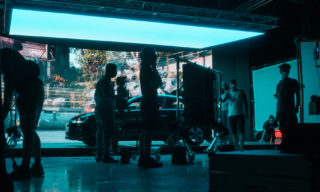Blockbusters are changing the way we create video content
Content marketing is a blend of entertainment and advertising (or at least it ought to be!), which is why movies have always been a huge source of inspiration for generations of brand-folk like you and us.
One of the latest technologies to take Hollywood by storm is virtual production. A new, innovative way to create the interactive environments of your wildest dreams. It’s still in its early days, but we can already see that the opportunities for video content are huge.
Also, it’s just really cool and we can’t stop talking about it. We even talked about it our podcast with 20-year feature film and CG digital artist, Ben Radcliffe! (and on our recent Linkedin Live!)
What is virtual production?
Virtual production is a type of technology that allows you to mix live footage and computer graphics at once.
“Ahh like when you see actors in front of those big green screens?”
Kinda, but virtual production has a few key differences.
With traditional green screen and CGI, it looks like this:
Actors perform in front of green screens > 3D animators create the environment post-production > Live footage and 3D environment are combined + lots of more editing and perfecting.
You can see this type of filmmaking in some of your favourite movies like Harry Potter, The Avengers, and X-Men.

With virtual production, it’s more like this:
A team creates the virtual world in pre-production > Actors perform in front of a LED backdrop of the virtual environment > Any changes to the environment are made in real-time > The footage is edited, just like you’d edit footage that’s shot on a live set or location.
Basically, virtual production is like virtual reality, meets the gaming world, meets videography. As it’s still new, there aren’t a lot of examples, but if you happened to catch the latest Lion King or The Mandalorian, you have seen virtual production in action.
How does virtual production work?
Virtual production environments are created using something called a game engine. A game engine is a piece of software that allows you to create digital environments that behave like real environments, through a combination of immersive technologies such as virtual reality, augmented reality, and CGI. It’s called a game engine because—you guessed it—it’s the same software that game developers use to build video games.
Just like a video game, these virtual worlds are jam-packed with details that make up the digital set (eg: backgrounds, buildings, characters). When this ‘digital set’ is placed on giant LED screens, the director can request edits in real-time, from moving objects around, to changing locations and even adjusting the lighting of a scene in just a few clicks.
If you want to know more, this video does a really good job of showing how it works 👇
What are the benefits of virtual production?
- You can create any world you could ever imagine
- Don’t like where that rock’s sitting? Move it in real-time
- You can see what the footage will look like, right there in front of you
- You don’t need to build an entire physical set or jet across the world for that one shot you need in front of the Chrysler Building, you can just create it digitally
- Teams can shoot everything in one studio
- The camera tracking is done pre-production, so you can shoot like you’re filming in a real environment
- Because you can see the full scene, there are typically fewer edits in comparison to traditional 3D animation. This makes it faster, more efficient, and even cheaper
- Easily place real actors in a digital world, which means you don’t always have to animate humans (if you know, you know)
- It gives actors a better experience as they aren’t asked to imagine the world they’re acting in. This once made Sir Ian McKellen cry on the set of The Hobbit
- The virtual environment lights the set—so if you switch the sky to a sunset, you can expect that warm orange glow (or whatever you fancy)
- Unreal—the current leading software for virtual production—is free.
What are the drawbacks of virtual production?
- Right now, it’s new, so there aren’t a lot of examples to reference (although, that’s not always a bad thing)
- There aren’t a lot of virtual production studios in the UK at this moment (but there will be soon)
- It can be expensive to build a virtual production studio from scratch
What does this mean for video content creation?
The thing about any form of 3D animation is that you can be as inventive as you want to be—no idea is too big and there’s no such thing as ‘crazy’. However, authenticity is a huge focus for a lot of brands and because of this, they often want to create something with real footage. Virtual production allows you to do both and as it’s new, you can push the boundaries and create something that’s never really been done before.

If you’re a global brand, virtual production also gives you the tools to capture various locations all over the world, from one single studio. This level of efficiency will allow you to be more reactive than ever.
As always, film studios are front-runners when it comes to technology. Thankfully, we have access to so much information now that we can jump on these new innovations quicker than we could before. Virtual production is already here and it’s only a matter of time before it becomes a go-to for creating video content for brands.
How we can help
Our content production team of CG animators and filmmakers know how to deliver impactful, world-class content that drives business results. We can bring your brand message to life across every platform and medium.







